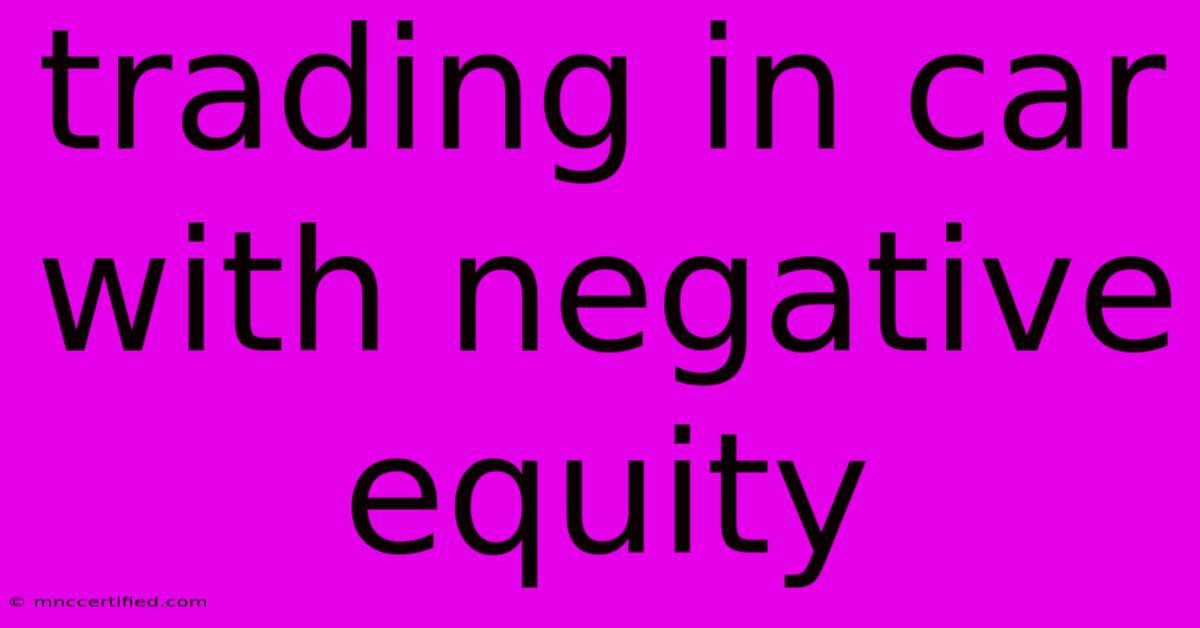Trading In Car With Negative Equity

Table of Contents
Stuck with Negative Equity? How to Trade in Your Car When You Owe More Than It's Worth
We've all been there: you love your car, but you're ready for something new. But then you realize the harsh reality of negative equity – you owe more on your car loan than it's currently worth. This can feel like a major setback, leaving you wondering if trading in your car is even an option.
Don't worry, it's not impossible! While it's true that negative equity can make trading in your car more challenging, it's not a deal breaker. Here's a breakdown of what negative equity is, how to navigate it, and strategies for making a successful trade-in:
Understanding Negative Equity
Negative equity, also known as being "underwater" on your loan, occurs when the outstanding balance on your car loan is higher than the current market value of your car. This happens for a few reasons:
- Depreciation: Cars naturally lose value over time, especially during the first few years.
- High Loan Amount: Taking out a loan with a longer term or a higher interest rate can lead to a larger outstanding balance.
- Unexpected Damage: Accidents or repairs can further lower your car's value.
Navigating Negative Equity: Options & Strategies
1. Increase Your Down Payment:
The most common strategy to offset negative equity is to increase your down payment on the new vehicle. This directly reduces the loan amount you'll need to take out, potentially bringing the loan balance closer to or even below the value of the new car.
2. Extend Your Loan Term:
Extending the term of your loan can lower your monthly payments, but it also means you'll pay more interest over the long run. Carefully consider if this is a worthwhile trade-off based on your financial situation.
3. Trade-in Plus Cash:
If the negative equity is significant, you may need to make a cash payment on top of your trade-in to cover the difference. This can be a challenge, but it's often the best solution to get into a new car sooner.
4. Sell Your Car Privately:
While selling your car privately may take more time and effort, it could potentially fetch you a higher price than a trade-in value. This can help minimize the amount of negative equity you carry over to the new vehicle.
5. Wait It Out:
If you're not in a hurry, consider waiting until your car has appreciated in value. This could take several years, but it will help you avoid any negative equity when you eventually decide to trade in.
6. Refinance Your Existing Loan:
If you can qualify for a lower interest rate on your current car loan, it can significantly reduce your outstanding balance and minimize negative equity.
Tips for Maximizing Your Trade-in Value
- Maintain Your Car: Regular maintenance and keeping your car clean can boost its resale value.
- Shop Around: Get quotes from multiple dealerships to see who offers the best trade-in value.
- Negotiate: Don't be afraid to negotiate with the dealership to secure a better offer.
- Consider Pre-owned: Choosing a pre-owned vehicle could help you avoid substantial negative equity in the future.
Conclusion
Negative equity can be a frustrating obstacle when you're looking to trade in your car. However, by understanding your options and applying the strategies outlined above, you can navigate this situation and get behind the wheel of your dream car. Remember, communication is key. Be honest with your dealership about your financial situation, and work together to find a solution that fits your needs.

Thank you for visiting our website wich cover about Trading In Car With Negative Equity. We hope the information provided has been useful to you. Feel free to contact us if you have any questions or need further assistance. See you next time and dont miss to bookmark.
Featured Posts
-
Rivian Stock Surges On Joint Venture News
Nov 14, 2024
-
Cava Stock Outlook Buy Sell Hold
Nov 14, 2024
-
Us Coastal Insurance Company Rating
Nov 14, 2024
-
Player Grades Sixers Vs Cavs Mc Cains Review
Nov 14, 2024
-
Tatum Goes Shirtless Post Kravitz Split
Nov 14, 2024